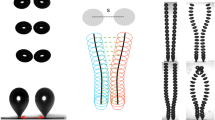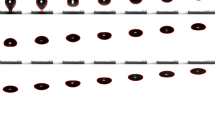Abstract
The rising behavior of bubbles undergoing bubble-bubble interaction in a viscous liquid is studied using a two-dimensional direct numerical simulation. Level contour reconstruction method (LCRM), one of the connectivity-free front tracking methods, is applied to describe a moving interface accurately under highly deformable conditions. This work focuses on the effects of bubble size on the interaction of two bubbles rising side-by-side in a stagnant liquid. Several characteristics of bubble-bubble interaction are analyzed quantitatively as supported by energy analysis. The results showed clear differences between small and large bubbles with respect to their interaction behavior in terms of lateral movement, vortex intensity, suppression of surface deformation, and viscous dissipation rate. Distributions of vorticity and viscous dissipation rate near the bubble interfaces also differed depending on the size of the bubbles. Strong vortices from large bubbles triggered oscillation in bubble-bubble interaction and played a dominant role in the interaction process as the size of bubbles increases.
Similar content being viewed by others
References
R. Clift, J. Grace and M. E. Weber, Bubbles, drops and particles, Dover Publications, Inc., New York, USA (1978).
J. Magnaudet and I. Eames, The motion of high-Reynoldnumber bubbles in inhomogeneous flows, Annu. Rev. Fluid Mech., 32 (2000) 659.
D. Sanada, M. Shirota and M. Watanabe, Bubble wake visualization by using photochromic dye, Chem. Eng. Sci., 62 (2007) 7264–7273.
B. Bunner and G. Tryggvason, Effect of bubble deformation on the properties of bubbly flows, J. Fluid Mech., 495 (2003) 77–118.
D. Bhaga and M. E. Weber, Bubbles in viscous liquids: shapes, wakes and velocities, J. Fluid Mech., 105 (1981) 61–85.
G. Son, Numerical study on a sliding bubble during nucleate boiling, Journal of Mechanical Science and Technology, 15 (7) (2001) 931–940.
Y. S. Chang, K. H. Jeong, H. J. Lee, Y. P. Lee and H. Y. Kim, Behavior of thermal bubbles formed from a single nucleation site, Journal of Mechanical Science and Technology, 24 (2010) 415–420.
A. Tomiyama, G. P. Celata, S. Hosokawa and S. Yoshida, Terminal velocity of single bubbles in surface tension force dominant regime, Int. J. Multiphase Flow, 28 (2002) 1497–1519.
L. Amaya-Bower and T. Lee, Numerical simulation of single bubble rising in vertical and inclined square channel using lattice Boltzmann method, Chem. Eng. Sci., 66 (2011) 935–952.
J. Hua, J. F. Stene and P. Lin, Numerical simulation of 3D bubbles rising in viscous liquids using a front tracking method, J. Comput. Phys., 227 (2008) 3358–3382.
T. Bonometti and J. Magnaudet, An interface-capturing method for incompressible two-phase flow. Validation and application to bubble dynamics, Int. J. Multiphase Flow., 33 (2007) 109–133.
D. Legendre, J. Magnaudet and G. Mougin, Hydrodynamic interactions between two spherical bubbles rising side by side in a viscous liquid, J. Fluid Mech., 497 (2003) 133–166.
Z. Yu, H. Yang and L. S. Fan, Numerical simulation of bubble interactions using an adaptive lattice Boltzmann method, Chem. Eng. Sci., 66 (2011) 3441–3451.
S. Shin, S. I. Abdel-Khalik, V. Daru and D. Juric, Accurate representation of surface tension using the level contour reconstruction method, J. Comput. Phys., 203 (2005) 493–516.
S. Shin and D. Juric, Modeling three-dimensional multiphase flow using a level contour reconstruction method for front tracking without connectivity, J. Comput. Phys., 180 (2002) 427–470.
S. Shin and D. Juric, High order level contour reconstruction method, Journal of Mechanical Science and Technology, 21 (2) (2007) 311–326.
S. Shin and D. Juric, A hybrid method for threedimensional multiphase flows based on front tracking and level set techniques, Int. J. Num. Methods Fluids, 60 (2009) 753–778.
J. Chorin, Numerical solution of the Navier-Stokes equations, Math. Comput., 22 (1968) 745–762.
S. Shin et al., Numerical modeling of evaporating thin liquid film instability on a heated cylindrical rod with parallel and cross vapor flow, Nuclear Science and Engineering, 156 (2006) 1–16.
K. Sankaranarayanan, I. G. Kevrekidis, S. Sundaresan, J. Lu and G. Tryggvason, A comparative study of lattice Boltzmann and front tracking finite-difference methods for bubble simulations, Int. J. Multiphase Flow., 29 (2003) 109–116.
Author information
Authors and Affiliations
Corresponding author
Additional information
Recommended by Associate Editor Shin Hyung Rhee
Ikroh Yoon received his B.S. and M.S. degrees from Hongik University in 2009 and 2011, respectively. He is currently a senior researcher working at the Korea Institute of Marine Science and Technology Promotion. His research interests include computational fluid dynamics for multiphase flows.
Seungwon Shin received his B.S. and M.S. degrees in Mechanical Engineering from Seoul National University, Korea in 1995 and 1998, respectively. He received his Ph.D. from Georgia Tech. in 2002. Dr. Shin is currently a professor at the School of Mechanical and System Design Engineering at Hongik University in Seoul, Korea. Dr. Shin’s research interests include computational fluid dynamics, multiphase flow, surface tension effect and phase change process.
Rights and permissions
About this article
Cite this article
Yoon, I., Shin, S. Numerical investigation of interaction between rising bubbles in a viscous liquid. J Mech Sci Technol 30, 3165–3172 (2016). https://doi.org/10.1007/s12206-016-0627-2
Received:
Revised:
Accepted:
Published:
Issue Date:
DOI: https://doi.org/10.1007/s12206-016-0627-2




